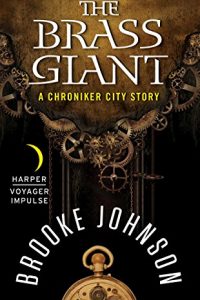 With Brooke Johnson’s second book in the Chroniker City series, The Guild Conspiracy, coming out today I thought now would be a good time to talk about the first book in the series: The Brass Giant.
With Brooke Johnson’s second book in the Chroniker City series, The Guild Conspiracy, coming out today I thought now would be a good time to talk about the first book in the series: The Brass Giant.
Our story follows Petra Wade, an incredibly gifted late 19th century young woman who lives in Chroniker City, a mechanical city built on an island off the coast of Wales that is a utopia for engineers and scientists. She works in a shop that repairs clocks and clockwork gadgets for people since her gender means she can’t attend Chroniker University or join the Guild that rules Chroniker City, despite being the most gifted tinker of her age.
A chance encounter, however, with Emmerich Goss, a young and handsome Guild trainee, means she may get her chance to showcase her skills. Emmerich is building an experimental automaton for the Guild and needs Petra’s help, which Petra agrees to do after some hesitation. The project, however, doesn’t go as planned, and it is soon discovered that a conspiracy within the Guild plans to use the automaton as a war machine. Accused of being a traitor and spy, Petra now has to protect herself and her loved ones while finding a way to stop a devastating war from breaking out.
This plot outline makes it seem that The Brass Giant is your usual run-of-the-mill steampunk adventure, but there is more to it than that. Much of the story is spent following Petra and Emmerich’s budding romance. Now, I don’t want to sound like a pre-adolescent boy who is afraid girls are going to give him cooties, but I have to be honest and say that romance novels aren’t for me. I don’t judge anyone who enjoys them, my mom and wife certainly like them, but I am not part of the target demographic for the story. Still when am I ever going to get a chance to talk about the concept of “romance” in science fiction?
Most people are familiar with the Disney version of romance: two people meet and they fall in love at first sight. It’s a silly, outdated concept, but it continues to show up again and again in fiction. Surprisingly a lot of relationships in science fiction works fall into this category. Usually there is a dashing space hero and a maiden who needs to be rescued, but modern works tend to give relationships more depth these days. Characters are more fleshed out, have flaws and tend to be on an equal footing within the relationship. You also tend to see more people of color or non-heterosexual couples, which is good because not all readers are white, heterosexual males and they want relationships they can identify with in their fiction.
An example of a good portrayal of real love, in my opinion, is from the anime series Robotech. In the first series, when we are not watching transforming robots duke it out, we follow Rick Hunter and his confusing love life. He has strong emotions for the attractive singer, Lynn Minmei, but she can be flighty and unpredictable; she often forgets about Rick when something better comes along. Then there is Lisa Hayes, a serious and career-minded military officer, who often clashes with Rick, but both soon find they have a lot of things in common. What I liked about Robotech‘s love triangle is that it showed how complicated and messy love can be, and it was probably one of my first examples of a fictional relationship besides the fairy tale love story.
I found Petra and Emmerich’s romance to be believable. They are both young, attractive people who share an interest in engineering and have to spend long hours with each, so who would be really surprised if they came to be romantically involved? I thought the reveal that they knew each other as little children was a tad coincidental, but it worked within the framework of the story. Still, I am a firm believer in the theory that you can never truly say you love someone unless one of you farts and both burst out laughing.
Petra and Emmerich are certainly in the “puppy dog” love phase, where everything is perfect and kissy face. They have never really gotten a chance to slow down (what with all the people trying to hurt and/or kill them) and see each other as their yucky human selves. Would their love last the test of time once all the bad guys have been beaten? Maybe, but that is a phase of a relationship we don’t usually get to see in fiction. After “they all lived happily ever after” who really wants to read about someone’s life that doesn’t involve crashing a giant clockwork robot through a floor?
Speaking of clockwork robots, The Brass Giant is a good steampunk adventure. I know a lot of alternate historians turn their noses up at the steam and goggles crowd, but I like it. The world-builder in me did want to know more about what was different about this timeline outside of Chroniker City, but I get a feeling that is something the sequels may cover in more detail. As for the technical aspects of the book, it’s a well written story. It was a short book, however, so it is a pretty quick read.
That all being said, I’m not going to pretend I was excited by the romance sub-plot, but from a completely theoretical point of view, it was handled fine. Plus it allowed me to talk about a subject I don’t usually get a chance to cover. So if you ever wanted to read a steampunk romance, I can recommend The Brass Giant.










